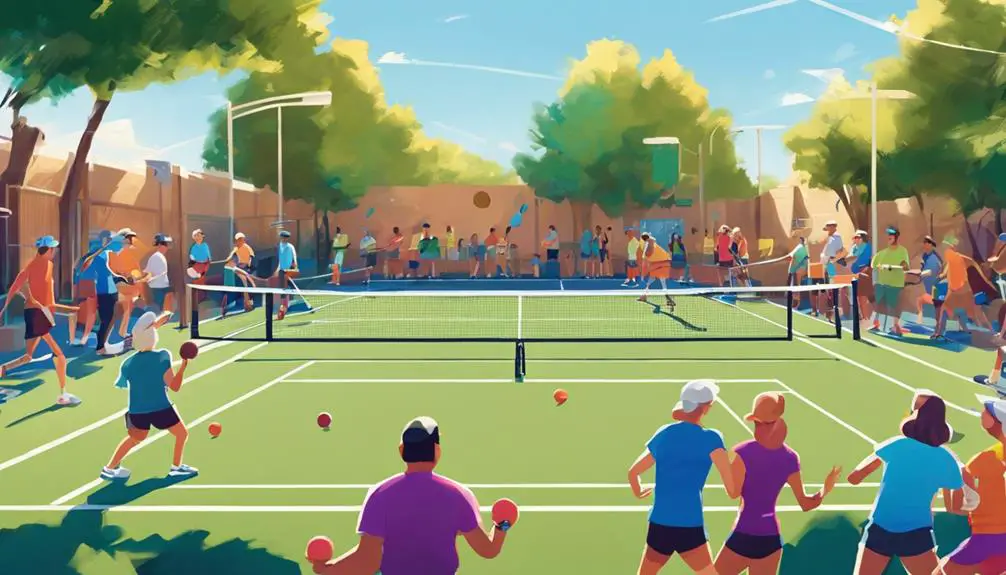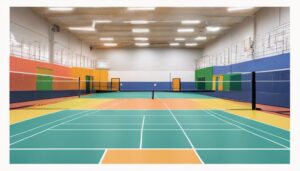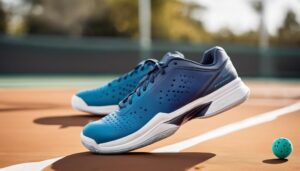Absolutely, you can play pickleball on grass! Many players enjoy the softer surface, which can reduce joint impact and create a more relaxed atmosphere. However, keep in mind that grass can be slippery and may affect ball bounce. Setting up a temporary court with clear markings is essential, and it’s crucial to check the ground conditions before you play. Also, consider using paddles with a larger surface for better control on this surface. Interested in tips for enhancing your grass pickleball experience? There’s much more to explore!
Understanding Pickleball Basics
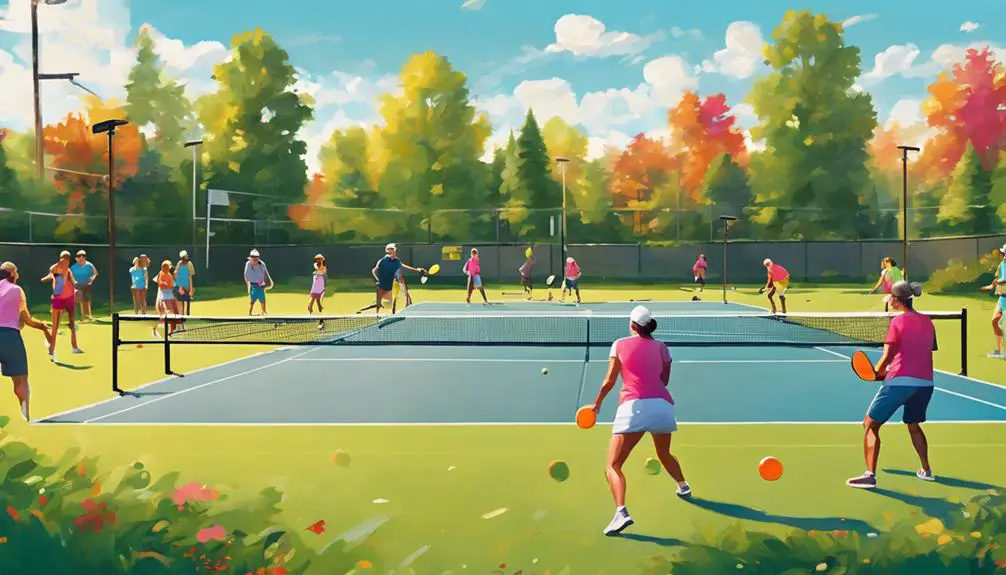
Have you ever wondered what makes pickleball such a popular sport? Its unique blend of fun, strategy, and accessibility has drawn players of all ages. To appreciate this dynamic game fully, it’s crucial to understand its history and rules. Pickleball originated in 1965 on Bainbridge Island, Washington, where a group of friends sought to create a new game to entertain their families. They combined elements from tennis, badminton, and ping pong, leading to a sport that’s easy to learn yet challenging to master.
The game is played on a court similar to a badminton court, but with specific dimensions. You’ve got a net that stands 36 inches high at the sides and 34 inches at the center. The rules are straightforward: two or four players use paddles to hit a lightweight plastic ball over the net, aiming to score points by landing the ball in the opponent’s court. The serving team must hit the ball diagonally, and both teams must let the ball bounce once before volleying it.
One critical aspect is the non-volley zone, often called the “kitchen,” which prevents players from smashing the ball right at the net. This rule encourages strategic play and keeps the game moving fluidly. So, whether you’re looking to play leisurely or competitively, knowing the history and game rules of pickleball will help you appreciate its charm and freedom.
Benefits of Playing on Grass
Playing pickleball on grass offers a rejuvenating twist to the traditional experience. You’ll find that the grass surface advantages can enhance your game while providing a unique and invigorating setting. One of the most significant benefits is the cushioning effect of grass, which reduces the impact on your joints. This can be particularly appealing for players who might be concerned about injuries or discomfort during play.
Moreover, playing on grass allows for a softer landing when you dive for that tricky shot or sprint to the net. You’ll enjoy the feeling of being surrounded by nature, adding to the overall outdoor enjoyment of the sport. The vibrant green grass creates a picturesque backdrop, making each match feel like a mini getaway from the daily grind.
Another advantage is the potential for longer rallies. The grass can slow down the ball slightly, giving you more time to react and strategize your next move. This not only keeps the game more engaging but also allows for opportunities to improve your skills.
Additionally, the social aspect of playing outdoors can’t be overlooked. Gathering with friends and family on a sunny day to enjoy a game on the grass creates a relaxed atmosphere that indoor courts simply can’t replicate. It’s about freedom, fun, and fresh air. So grab your paddle and head to the nearest grass court; you might just discover a new favorite way to play pickleball!
Challenges of Grass Surfaces
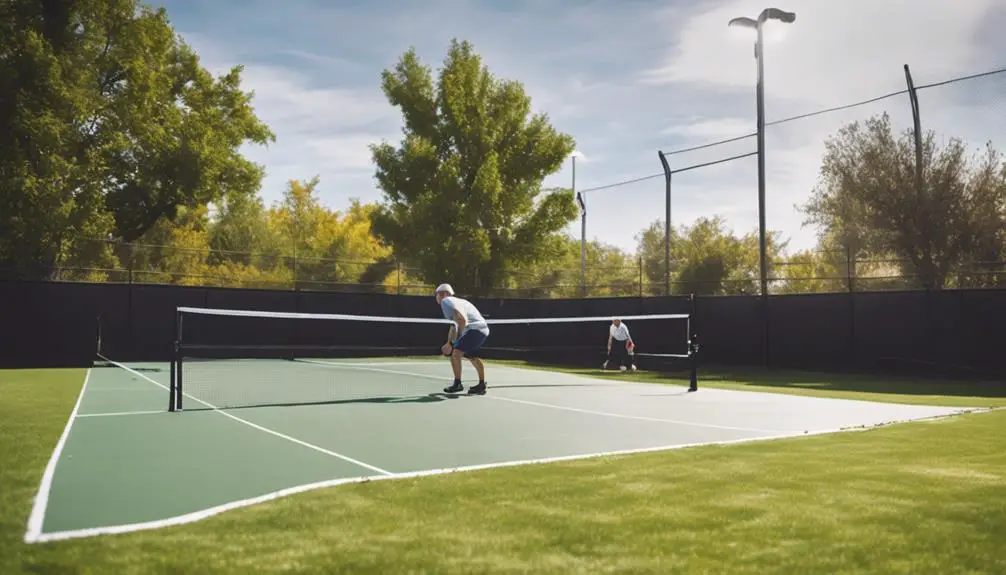
While the charm of playing pickleball on grass is undeniable, there are several challenges that come with this unique surface. One of the primary concerns is surface traction. Grass, unlike traditional courts, can be slippery, especially when wet. This can lead to unpredictable movements during play, increasing the risk of falls and injuries. You’ll find yourself needing to adapt your footwork, which can be frustrating.
Another significant challenge is the weather impact. Rain can turn a grassy area into a muddy mess, making it unsuitable for play. Even a light drizzle can lead to soggy conditions, resulting in a less enjoyable experience. The maintenance of grass courts also requires constant attention, as uneven patches or overgrown areas can disrupt gameplay.
Here’s a quick overview of some challenges you might face:
| Challenge | Description |
|---|---|
| Surface Traction | Grass can be slippery, affecting movement and safety. |
| Weather Impact | Rain can make the surface unplayable and muddy. |
| Maintenance Needs | Grass requires regular mowing and care. |
| Inconsistent Bounce | The ball may not bounce consistently on grass. |
| Limited Playability | Conditions can vary greatly with weather changes. |
Understanding these challenges can help you prepare better for your games. You might need specialized footwear or adjust your playing style, but with the right mindset, you can still enjoy the freedom of playing pickleball on grass!
Court Setup Considerations
Setting up a pickleball court on grass requires careful planning to guarantee an ideal playing experience. First off, you’ll need to take into account the court dimensions. A standard pickleball court measures 20 feet wide by 44 feet long for doubles play, so make sure you have enough space to accommodate these measurements. When marking your court, use temporary lines or cones that won’t damage the grass, allowing for easy adjustment if needed.
Next, it’s essential to evaluate the surface texture of your grass. Ideally, you want a well-maintained lawn with short, even grass that provides a suitable playing surface. Long or uneven grass can affect ball bounce and player movement, leading to an unsatisfactory game. If your grass is too thick, think about mowing it down to create a smoother playing field.
You should also reflect on the overall layout. Position your court in an area that’s free from obstacles, like trees or furniture, to prevent distractions and enhance safety. Additionally, make certain there’s a buffer zone around the court to allow for running space and to avoid collisions.
Lastly, keep in mind the weather conditions. Grass can become slippery when wet, so it’s best to avoid playing in rainy conditions. By carefully evaluating these court setup factors, you’ll set the stage for an enjoyable and competitive pickleball experience on grass.
Equipment Adjustments Needed
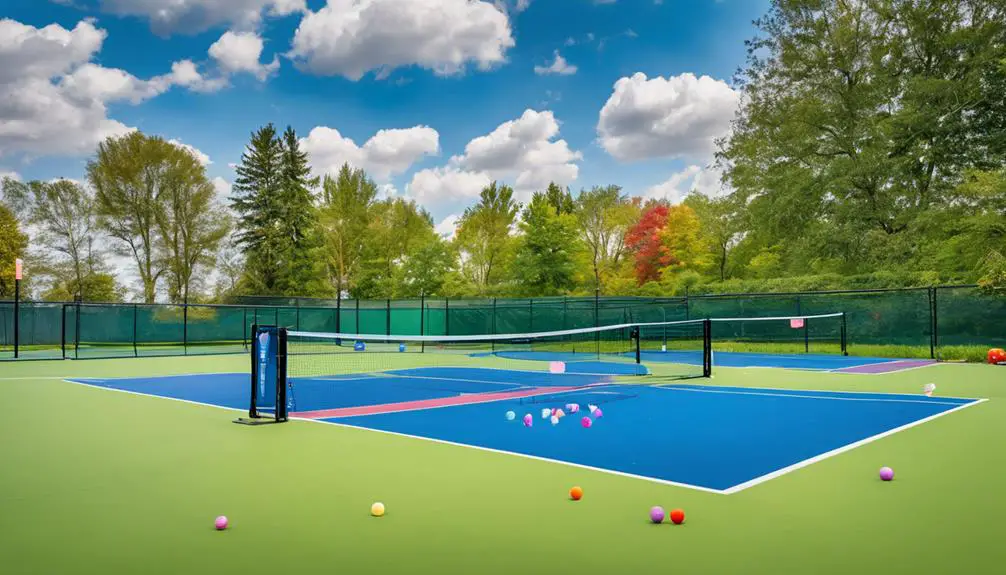
After ensuring your grass court is set up properly, it’s time to reflect on the equipment you’ll need for a successful game of pickleball. The first thing to take into account is paddle selection. On grass, you might want to opt for paddles that have a larger surface area and a bit more weight. This can help with control and power, especially when the ball’s bounce is influenced by the softer surface. Your paddle choice can greatly affect your gameplay, so experiment with different styles to find what feels best on grass.
Next, think about how the ball performs on this unique surface. Standard pickleballs may behave differently on grass compared to traditional courts. They might not bounce as high or as consistently, so you may want to try using a ball specifically designed for grass or one that’s slightly firmer. This can enhance your game and accommodate the grass’s impact on ball performance.
Additionally, contemplate the footwear you wear. Opt for shoes that provide good traction on grass to prevent slipping while allowing for quick movements. It’s all about adapting to the environment so you can play with confidence.
Player Safety and Injuries
Ensuring player safety on a grass pickleball court is essential for an enjoyable experience. While playing on grass can offer a unique and fun twist to the game, it also comes with specific risks that you need to be aware of. To minimize injuries, focus on injury prevention strategies and stay mindful of the playing surface.
First, you should assess the grass condition before starting a match. Uneven or wet areas can increase the likelihood of slips and falls. So, always check for any potential hazards, like holes or debris, that could lead to injuries. Wearing appropriate footwear is critical too; choose shoes with good traction to help maintain balance and stability during quick movements.
Player awareness is another key factor in maintaining safety while playing. Stay alert not only to your surroundings but also to your fellow players. Communication is essential—make sure everyone knows the court boundaries and potential obstacles. When you’re aware of each other’s positions, you can avoid collisions and other accidents.
Lastly, don’t hesitate to take breaks. Playing on grass can be more taxing on your body than you might expect. If you start feeling fatigued, it’s better to rest than risk an injury. By prioritizing player safety through awareness and proactive measures, you can enjoy the freedom of playing pickleball on grass while minimizing the chance of injuries.
Grass Maintenance Tips
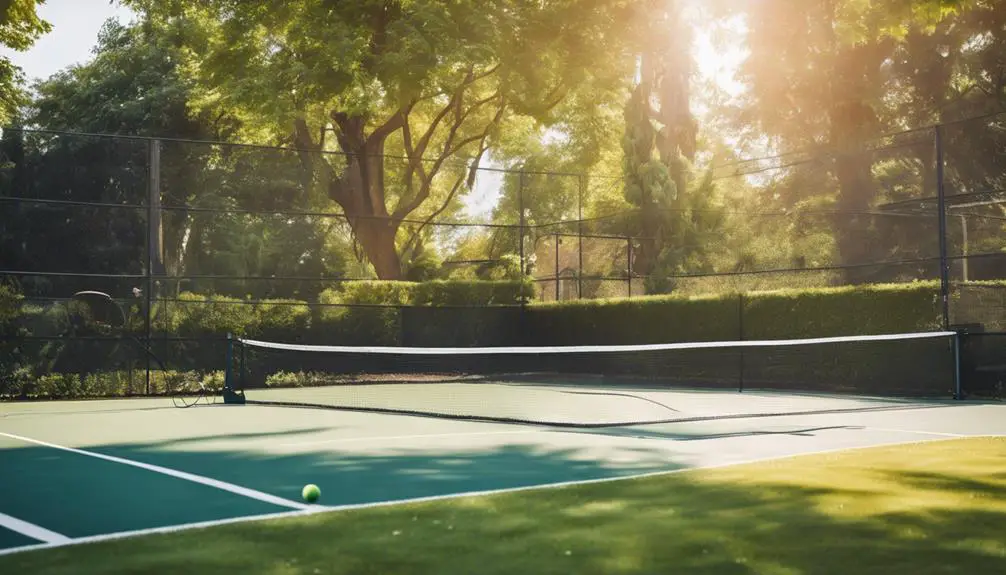
To maintain a lush and playable grass court for pickleball, regular upkeep is essential. A well-kept court not only enhances your playing experience but also keeps the grass healthy and resilient. Start with effective mowing techniques. It’s best to mow your grass regularly, keeping it at a height of about 2 to 3 inches. This height allows the grass to thrive while providing a smooth surface for gameplay. Be sure to use a sharp mower blade to prevent tearing, which can lead to disease.
Next, consider soil aeration. Aerating your soil helps improve water absorption and nutrient flow, promoting a healthier grass system. You can aerate by using a core aerator, which removes small plugs of soil, allowing air to penetrate deeper. Aim to aerate at least once a year, preferably in the spring or fall when grass is actively growing.
Don’t forget about watering! Your grass needs consistent moisture, especially during dry spells. Water deeply but less frequently to encourage deep root growth. A good rule of thumb is to aim for about 1 to 1.5 inches of water per week.
Popular Grass Playing Locations
Finding the right location to play pickleball on grass can elevate your experience, especially when the court is well-maintained. There are some unique grass venues around the country that not only offer a fantastic playing surface but also an enjoyable atmosphere. Parks, community centers, and even private clubs often have grassy areas where you can set up your game.
One standout option is the annual grass tournament held at the famed Wimbledon grounds. This historical grass tournament isn’t just for tennis anymore; it often welcomes pickleball enthusiasts, making it a unique experience for players who want to connect with the sport’s rich history. Playing on such a prestigious lawn adds an exciting flair to your game that you won’t find anywhere else.
Other popular grass venues include local festivals or outdoor events that facilitate pickleball courts for casual play. These settings allow you to immerse yourself in community spirit while enjoying the freedom of playing on a natural surface. Whether it’s a well-groomed backyard or a large public park, the key is to find a spot where you can enjoy the game without restrictions.
Expert Opinions and Insights

While many players enjoy the thrill of pickleball on traditional hard courts, experts agree that playing on grass can offer a unique set of benefits. The softer surface not only provides a different feel but also can enhance your game in various ways. Here’s what some experts have to say:
- Player Skill Levels: Grass courts can be more forgiving for beginners, allowing them to develop their skills without the harsh impact of harder surfaces.
- Injury Prevention: The cushioning effect of grass helps reduce the risk of joint injuries, making it a safer option for players of all ages.
- Unique Playing Experience: The slower pace on grass can encourage longer rallies and strategic play, making every match feel invigorating and engaging.
- Social Environment: Grass courts often promote a more relaxed, social atmosphere, allowing players to enjoy the game with friends and family.
When considering grass court dimensions, keep in mind that they should mimic those of traditional courts, usually 20 feet wide by 44 feet long for doubles. This consistency helps maintain the integrity of the game while adapting to a new surface.
Frequently Asked Questions
Is Pickleball on Grass Suitable for Beginners?
Playing pickleball on grass can be suitable for beginners. Grass court advantages include softer landings and less impact. Utilize beginner strategies like positioning and shot placement, letting you enjoy the game while building your skills confidently.
Can You Play Pickleball on Uneven Grass Surfaces?
Playing on uneven grass surfaces can feel like dancing on a bumpy road. While it challenges your game strategies, it’s possible. Just be ready for unpredictable bounces, and adapt your tactics for a fun experience!
Are There Specific Shoes Recommended for Grass Pickleball?
When playing on grass, you’ll want shoes with good traction and surface durability. Look for specialized outdoor court shoes to enhance your performance and comfort while enjoying the freedom of movement on various grass surfaces.
How Does Grass Affect Ball Bounce Compared to Hard Courts?
Imagine playing on lush grass; you’d notice the ball’s bounce differs from hard courts. Grass has more surface friction, affecting ball physics, leading to softer, unpredictable bounces that challenge your game strategy and adaptability.
What Weather Conditions Are Best for Grass Pickleball?
For ideal grass pickleball, aim for mild, dry weather. Avoid playing during heavy rain or extreme heat, as it affects grass maintenance and court conditions. Enjoy your game in pleasant temperatures for the best experience!

